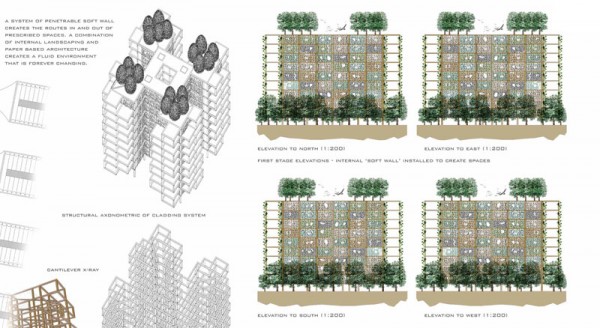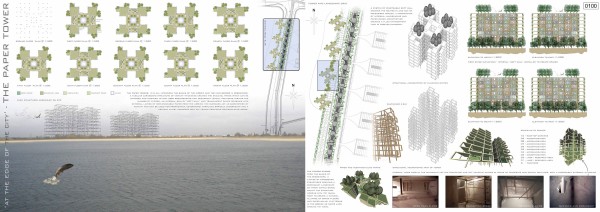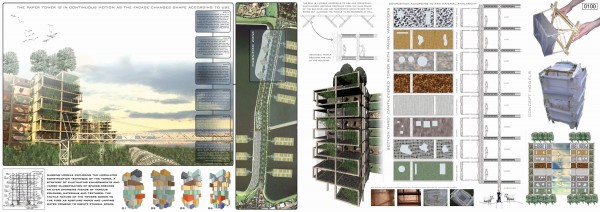Green Skyscrapers
In the next few days we will showcase 25 innovative proposals for green skyscrapers. These projects were submitted for the Annual Skyscraper Competition from 2006 to 2009.
Project 7 of 25
Alan Morrissey
United Kingdom
The prime focus of the study project was built around the phrase ‘untethered space’, and dealt with the cultural significance of the edge of the city, a mysterious place that adopts many forms and functions. For my project, which was based around the Staines and King Edvard IV Reservoirs near to Heathrow airport, I used the central road that bisects the reservoirs and the proximity of the airport as catalysts for the establishment of a new form of edge culture, built around the following self – imposed brief:
‘When Heathrow Airports’ proposed Terminal 5 was finally given the go – ahead by the British Government on the 20th November 2001, after a lengthy and costly public enquiry, this approval did not come without significant conditions attached to it. Throughout the enquiry several groups had voiced concerns over the environmental impact of a new terminal building on surrounding rural and wetland areas, the most vocal of which was Hacan Clear skies, who campaign for the rights of residents living within the flight path of Heathrow airport. Conscious of the fact that a new terminal would result in a significant increase in the volume of air traffic in and out of Heathrow, the Government applied a strong sustainability agenda to the development criteria of Terminal 5, stating that a suitable method for recycling waste products from both the airport and the T5 construction site must be founded through a partnership of the British Airport Authority, The Government and Hacan Clear skies responding directly to the escalating issues of sustainability and raw material recycling. The sustainability report cited the Staines and King Edward IV Reservoirs to the South West of Heathrow Airport as a potential site for such a development to occur, with initial co – funding being provided by the United Nations as a consequence of new policy derived from the 2003 Earth Summit in Johannesburg, and The British Government under its’ Local Agenda 21 sustainability policy. With the onset of construction of Terminal 5 the funding for this project has now become available, with British Airways having offered a further donation to aid the inception of the project and a promise to provide all paper based waste that it produces from Heathrow Airport.’
The Edge City
The edge city is a reproductive machine that is built up of multi – layered personalities, both culturally and architectonically. Starting life as a community and commercially based recycling centre, the project grows and morphs into a complex web of social interchanges, becoming occupied and taken over by the landscape whilst being managed and administered by its’ inhabitants. The A3044 Edge city is machine, consumer and producer all at the same time, taking raw materials and turning them back into useable products that can be traded or re – used for objects, clothing and even new forms of architecture. The ‘city’ behaves as a self – sufficient machine that is undergoing continuous change and metamorphosis; a living, breathing organism.
To achieve architecture without formally resorting to design was always the ambition in my mind. Behind this objective was the desire to achieve the obvious clarity of the inevitable; a collective cultural structure in which the concept became the architecture. In this approach there was no need to design new abstract forms. Here the idea or concept would result in all of the architectural, social and peri – urban effects that I could only dream of without any reliance on proportion, style or aesthetics. Instead of designing seductive shapes or forms, I positioned a principle from which everything else was derived, and allowed the edge city to exist in a morphological state.

















